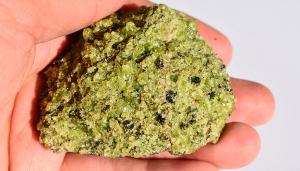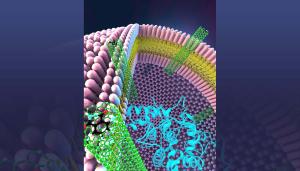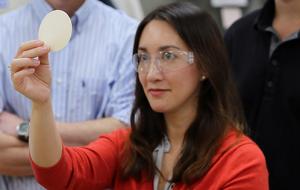LAB REPORT
Science and Technology Making Headlines
July 28, 2017


Thirteen exposures from the Hubble Space Telescope allowed astronomers to create a time-lapse showing the diminutive Phobos moon’s orbital path.
Photo bombing Mars
Over the course of 22 minutes, NASA’s Hubble Space Telescope took 13 separate exposures of Mars to study its surface. The observations were intended to photograph just Mars, but its moon, famed for its resemblance to the Star Wars Death Star, came in for a photo bomb.
NASA says the discovery of Phobos in the images was a bonus.
New calculations by physicists from Lawrence Livermore National Laboratory reveal Phobos could have survived a major impact, which left behind a massive crater, making it appear to look much like the Death Star. The researchers also consider a scenario in which an object 250 meters across made impact at roughly 4 miles per second.


A Lawrence Livermore engineer inspects the interface between the top flange of the high explosive canister and the electrical feedthrough spool in preparation for an experiment, which was conducted at the Nevada National Security Site on Oct. 12. Photo by Beth Dzenitis/LLNL
Nuclear shakedown
Rumblings of seismic waves reveal clues about North Korea’s nuclear weapons tests. On Sept. 9, 2016, seismometers began lighting up around East Asia. From South Korea to Russia to Japan, geophysical instruments recorded squiggles as seismic waves passed through and shook the ground. It looked as if an earthquake with a magnitude of 5.2 had just happened. But the ground shaking had originated at North Korea’s nuclear weapons test site.
Lawrence Livermore physicists have conducted an unprecedented set of six explosions at the U.S. nuclear test site in Nevada to mimic the physics of a nuclear explosion by detonating chemical explosives and watching how the seismic waves radiate outward. It’s like a miniature, nonnuclear version of a nuclear weapons test. The scientists have made some key discoveries, such as understanding how a deeply buried blast shows up in the seismic detectors.
The explosions ranged up to 5,000 kilograms of TNT equivalent and down to 87 meters deep, yet for all that firepower, the detonation barely registered on anything other than the instruments peppering the ground.
The explosives were set inside granite rock, a material very similar to the granite at Mount Mantap in North Korea. So the seismic waves racing outward behaved very much as they might at the North Korean nuclear test site, says William Walter, head of geophysical monitoring at LawrenceLivermore. The underlying physics, describing how seismic energy travels through the ground, is virtually the same for both chemical and nuclear blasts.


A mantle nodule collected from San Carlos, Arizona, brought to the surface during a deep volcanic eruption about 1 million years ago. Olivine, which is the focus of the LLNL study, is the predominant light green-colored mineral that is present in this rock. Photo by Wyatt Du Frane/LLNL
Water, water everywhere
As it turns out, water isn’t only found in the oceans, lakes and ponds on Earth. There actually is five times more water in the interior of Earth than an old theory proposed.
New work by Lawrence Livermore National Laboratory scientists shows the dispersal of water (incorporated as hydrogen in olivine, the most abundant mineral in the upper mantle), could account for high electrical conductivity seen in the asthenosphere (part of the upper mantle just below the lithosphere that is involved in plate tectonic movement).
Minerals formed deep in the mantle and transported to the Earth’s surface contain tens to hundreds of parts per million in weight of water, providing evidence for the presence of dissolved water in the Earth’s interior. Even at these low concentrations, water greatly affects the physico-chemical properties of mantle materials. The diffusion of hydrogen controls the transport of water in the Earth’s upper mantle, but until now was not fully understood for olivine.


A rendering of a 2D X-ray scattering pattern containing information about the multiscale structure of a carbon nanotube (CNT) 'forest' across four orders of magnitude in length scale. Image by Ryan Chen/LLNL
Carbon nanotubes stand at attention
Just as members of a marching band align themselves for a performance, carbon nanotubes create a similar configuration.
For the first time, Lawrence Livermore scientists have continuously mapped the multiscale structure of hierarchically self-organized carbon nanotubes across four orders of magnitude in length scale.
Researchers used synchrotron X-ray scattering to fully capture the hierarchical structure in self-organized carbon nanotube materials from the atomic to micrometer scale.
Complex hierarchical structures are made from synthetic nanotubes and graphene and could be used in several applications, including nanoelectronics, energy storage, filtration and separation.


A Lab researcher examines a 3D printed box that was "programmed" to fold and unfold when heated. Photo by Julie Russell/LLNL
Material goes back to where it once belonged
A research team from Lawrence Livermore has used a direct ink writing (DIW) process to 3D print property-specific, silicone meta materials that possess shape memory behavior, which technically makes them 4D printed.
LLNL has worked with both 3D printed metamaterials and 4D printing before, but by using a DIW process, the material becomes more lightweight and functional, with a tailored, mechanical response.
This can be achieved when printed structural porosity and intrastrand porosity are combined, by adding hollow, gas-filled microspheres into the 3D printing ink. But many researchers are adding different materials to the mix, such as these shape memory polymers, in order to increase the potential applications.





